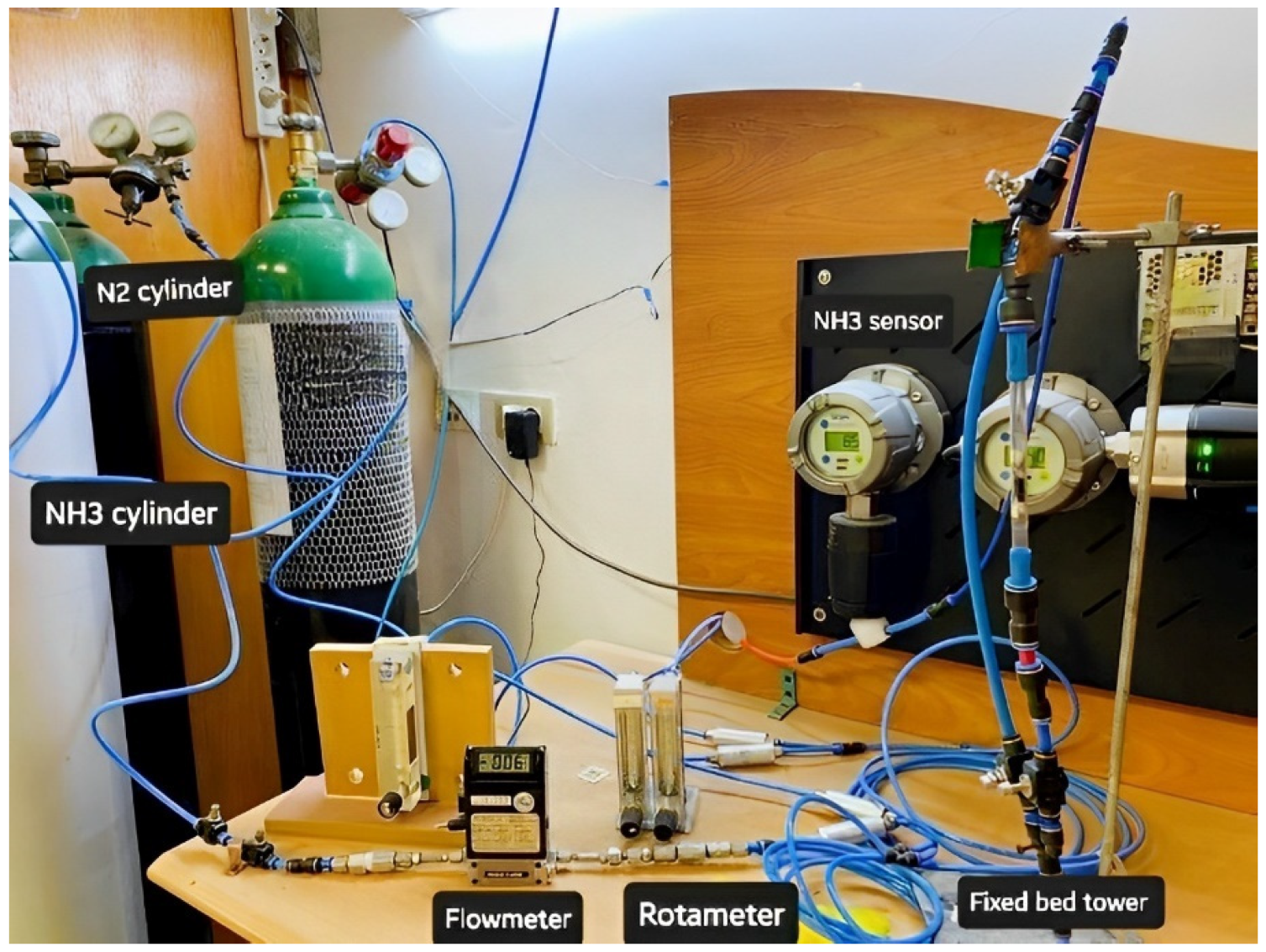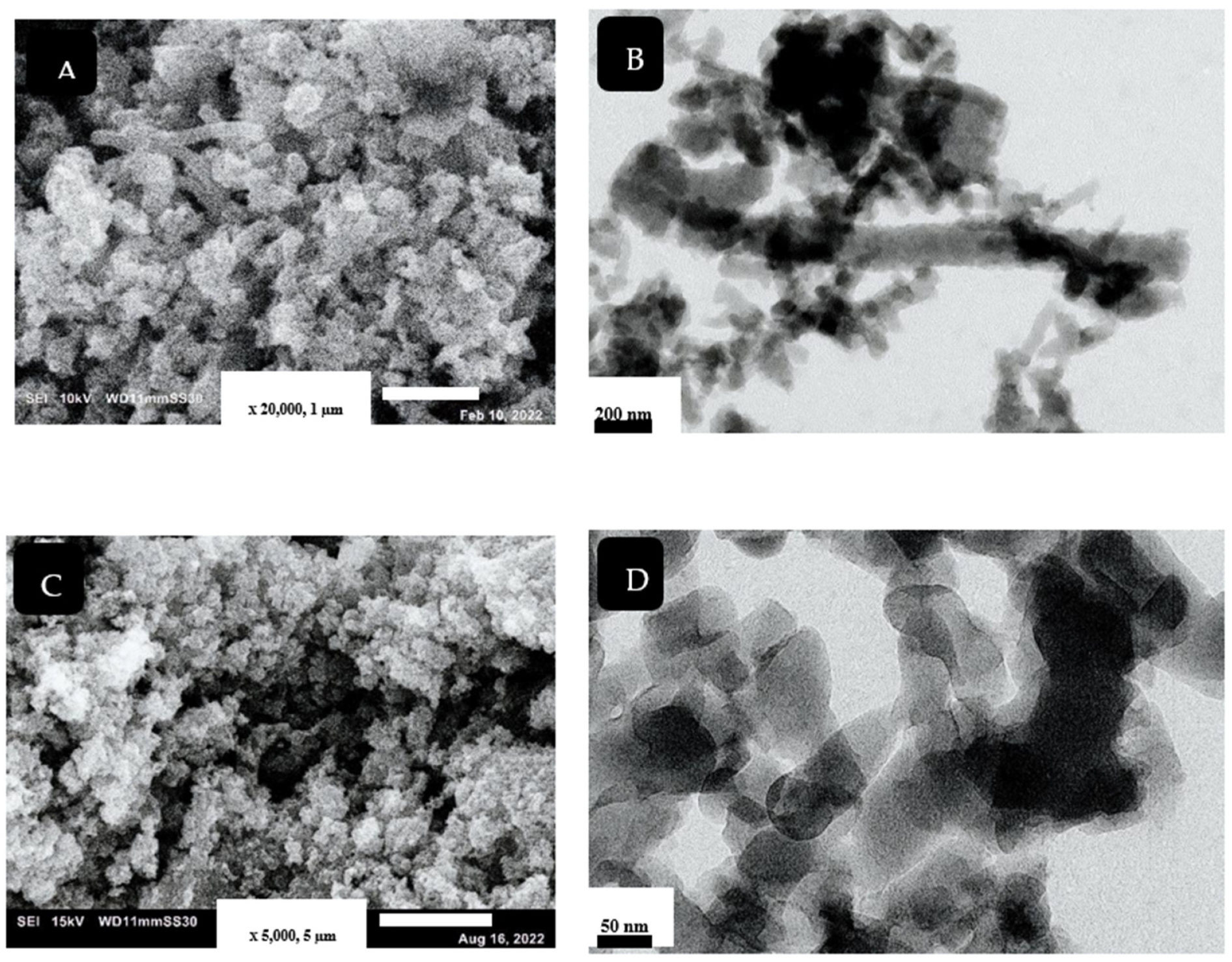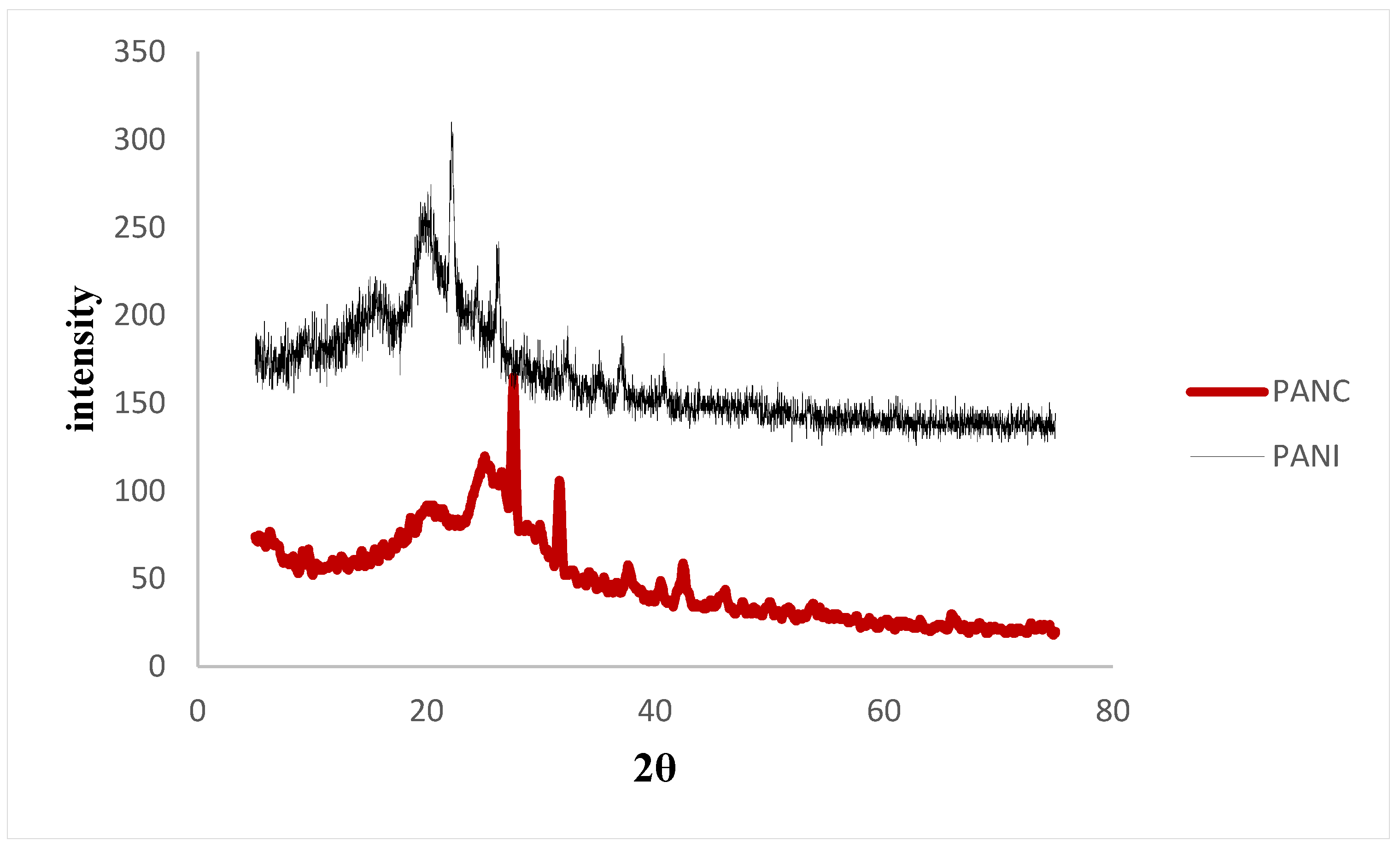Investigating the Adsorption Behavior of Polyaniline and Its Clay Nanocomposite towards Ammonia Gas
Abstract
1. Introduction
2. Materials and Methods
2.1. PANI and PANC Synthesis
2.2. Gas Adsorption Experimental Setup
3. Results
3.1. PANI/PANC Synthesis and Characterization
3.1.1. Morphology Characterization
3.1.2. Adsorbents BET Surface Area
3.1.3. FTIR and XRD
3.2. Gas Adsorption Experiments
4. Conclusions
Author Contributions
Funding
Institutional Review Board Statement
Informed Consent Statement
Data Availability Statement
Conflicts of Interest
References
- Zhang, M.; Chen, J.; Mao, X.; He, Y.; Li, R.; Wang, M.; Wang, Y.; He, L.; Yuan, M.; Feng, X.; et al. Fluorescent Nonwoven Fabric with Synergistic Dual Fluorescence Emission for Visible and Selective Ammonia Gas Detection. Radiat. Phys. Chem. 2022, 201, 110453. [Google Scholar] [CrossRef]
- Ali, I.; Kashyout, A.E.H.B.; Tayel, M.; Shokry Hassan, H.; Rizk, M. Ruthenium (Ru) Doped Zinc Oxide Nanostructure-Based Radio Frequency Identification (RFID) Gas Sensors for NH3 Detection. J. Mater. Res. Technol. 2020, 9, 15693–15704. [Google Scholar] [CrossRef]
- Higgins, P.; Siddiqui, S.H. Efficacy of Polyaniline (PANI) Nanofibres for Capturing Diclofenac (DC) Drug from Its Aqueous Solutions. J. Indian Chem. Soc. 2022, 99, 100494. [Google Scholar] [CrossRef]
- Saha, B.; Debnath, A.; Saha, B. Fabrication of PANI@Fe–Mn–Zr Hybrid Material and Assessments in Sono-Assisted Adsorption of Methyl Red Dye: Uptake Performance and Response Surface Optimization. J. Indian Chem. Soc. 2022, 99, 100635. [Google Scholar] [CrossRef]
- Aarab, N.; Hsini, A.; Laabd, M.; Essekri, A.; Laktif, T.; Haki, M.A.; Lakhmiri, R.; Albourine, A. Theoretical Study of the Adsorption of Sodium Salicylate and Metronidazole on the PANi. Mater. Today Proc. 2020, 22, 100–103. [Google Scholar] [CrossRef]
- Zhao, S.; Liao, Y.; Xie, X.; Wang, Y.; Sun, Z. As2O3 Removal from Coal-Fired Flue Gas by the Carbon-Based Adsorbent: Effects of Adsorption Temperature and Flue Gas Components. Chem. Eng. J. 2022, 450, 138023. [Google Scholar] [CrossRef]
- Elizalde-Torres, J.; Hu, H.; Saniger, J.M. Comparison of NO2 and NH3 Gas Adsorption on Semiconductor Polyaniline Thin Films. Rev. Mex. De Física 2005, 51, 482–487. [Google Scholar]
- Abdelraheem, A.; H El-Shazly, A.; Elkady, M. Comparable Investigation of Polyaniline Behavior towards Gaseous Ammonia and Toluene Adsorption. Environ. Sci. Pollut. Res. 2019, 26, 3991–3999. [Google Scholar] [CrossRef]
- Park, C.; Johnston, A.S.; Kweon, H. Physical Filtration Efficiency Analysis of a Polyaniline Hybrid Composite Filter with Graphite Oxide for Particulate Matter 2.5. J. Appl. Polym. Sci. 2020, 137, 49149. [Google Scholar] [CrossRef]
- Khalili, S.; Khoshandam, B.; Jahanshahi, M. Synthesis of Activated Carbon/Polyaniline Nanocomposites for Enhanced CO2 Adsorption. RSC Adv. 2016, 6, 35692–35704. [Google Scholar] [CrossRef]
- Peyravi, M. Synthesis of Nitrogen Doped Activated Carbon/Polyaniline Material for CO2 Adsorption. Polym. Adv. Technol. 2018, 29, 319–328. [Google Scholar] [CrossRef]
- Srivastava, N.; Singh, Y.; Singh, R.A. Preparation of Intercalated Polyaniline/Clay Nanocomposite and Its Exfoliation Exhibiting Dendritic Structure. Bull. Mater. Sci. 2011, 34, 635–638. [Google Scholar] [CrossRef]
- Piri, S.; Zanjani, Z.A.; Piri, F.; Zamani, A.; Yaftian, M.; Davari, M. Potential of Polyaniline Modified Clay Nanocomposite as a Selective Decontamination Adsorbent for Pb(II) Ions from Contaminated Waters; Kinetics and Thermodynamic Study. J. Environ. Health Sci. Eng. 2016, 14, 20. [Google Scholar] [CrossRef]
- Nguyen-Thanh, D.; Block, K.; Bandosz, T.J. Adsorption of Hydrogen Sulfide on Montmorillonites Modified with Iron. Chemosphere 2005, 59, 343–353. [Google Scholar] [CrossRef]
- Minisy, I.M.; Salahuddin, N.A.; Ayad, M.M. Adsorption of Methylene Blue onto Chitosan–Montmorillonite/Polyaniline Nanocomposite. Appl. Clay Sci. 2021, 203, 105993. [Google Scholar] [CrossRef]
- Navarchian, A.H.; Joulazadeh, M.; Karimi, F. Investigation of Corrosion Protection Performance of Epoxy Coatings Modified by Polyaniline/Clay Nanocomposites on Steel Surfaces. Prog. Org. Coat. 2014, 77, 347–353. [Google Scholar] [CrossRef]
- Liu, E.; Sarkar, B.; Wang, L.; Naidu, R. Copper-Complexed Clay/Poly-Acrylic Acid Composites: Extremely Efficient Adsorbents of Ammonia Gas. Appl. Clay Sci. 2016, 121, 154–161. [Google Scholar] [CrossRef]
- Ouyang, W.; Zheng, S.; Wu, C.; Hu, X.; Chen, R.; Zhuo, L.; Wang, Z. Dynamic Ammonia Adsorption by FAU Zeolites to below 0.1 Ppm for Hydrogen Energy Applications. Int. J. Hydrog. Energy 2021, 46, 32559–32569. [Google Scholar] [CrossRef]
- Vo, H.T.; Kim, J.; Kim, N.Y.; Lee, J.K.; Joo, J.B. Effect of Pore Texture Property of Mesoporous Alumina on Adsorption Performance of Ammonia Gas. J. Ind. Eng. Chem. 2020, 91, 129–138. [Google Scholar] [CrossRef]
- Rodrigues, C.C.; de Moraes, D.; da Nóbrega, S.W.; Barboza, M.G. Ammonia Adsorption in a Fixed Bed of Activated Carbon. Bioresour. Technol. 2007, 98, 886–891. [Google Scholar] [CrossRef]
- Saha, D.; Deng, S. Adsorption Equilibrium and Kinetics of CO2, CH4, N2O, and NH3 on Ordered Mesoporous Carbon. J. Colloid Interface Sci. 2010, 345, 402–409. [Google Scholar] [CrossRef] [PubMed]
- Binaeian, E.; Li, Y.; Tayebi, H.A.; Yuan, D. Enhancing Toxic Gas Uptake Performance of Zr-Based MOF through Uncoordinated Carboxylate and Copper Insertion; Ammonia Adsorption. J. Hazard. Mater. 2021, 416, 125933. [Google Scholar] [CrossRef] [PubMed]
- Abdelraheem, A.; El-Shazly, A.H.; Elkady, M.F. Nanofiber Polyaniline and Polyaniline-Clay Nanocomposite Prepared via Sonochemical and Sol-Gel Techniques. Mater. Sci. Forum 2016, 860, 12–16. [Google Scholar] [CrossRef]
- Abdelraheem, A.; El-Shazly, A.H.; Elkady, M.F. Characterization of Atypical Polyaniline Nano-Structures Prepared via Advanced Techniques. Alex. Eng. J. 2018, 57, 3291–3297. [Google Scholar] [CrossRef]
- Ayad, M.; Zaghlol, S. Nanostructured Crosslinked Polyaniline with High Surface Area: Synthesis, Characterization and Adsorption for Organic Dye. Chem. Eng. J. 2012, 204, 79–86. [Google Scholar] [CrossRef]
- Xu, H.; Li, X.; Wang, G. Polyaniline Nanofibers with a High Specific Surface Area and an Improved Pore Structure for Supercapacitors. J. Power Sources 2015, 294, 16–21. [Google Scholar] [CrossRef]
- Zhou, F.; Wang, G.; Huang, F.; Zhang, Y.; Pan, M. Polyaniline Derived N- and O-Enriched High Surface Area Hierarchical Porous Carbons as an Efficient Metal-Free Electrocatalyst for Oxygen Reduction. Electrochim. Acta 2017, 257, 73–81. [Google Scholar] [CrossRef]
- Xia, H.; Narayanan, J.; Cheng, D.; Xiao, C.; Liu, X.; Chan, H.S.O. Formation of Ordered Arrays of Oriented Polyaniline Nanoparticle Nanorods. J. Phys. Chem. B 2005, 109, 12677–12684. [Google Scholar] [CrossRef]
- Karaoğlan, N.; Bindal, C. Synthesis and Optical Characterization of Benzene Sulfonic Acid Doped Polyaniline. Eng. Sci. Technol. Int. J. 2018, 21, 1152–1158. [Google Scholar] [CrossRef]
- Yoshimoto, S.; Ohashi, F.; Kameyama, T. Characterization and Thermal Degradation Studies on Polyaniline-Intercalated Montmorillonite Nanocomposites Prepared by a Solvent-Free Mechanochemical Route. J. Polym. Sci. B Polym. Phys. 2005, 43, 2705–2714. [Google Scholar] [CrossRef]
- Baby Suneetha, R.R.; Kulandaivel, S.; Vedhi, C. Synthesis, Characterisation and Electrochemical Application of Hybrid Nanocomposites of Polyaniline with Novel Clay Mineral. Mater. Today Proc. 2022, 48, 294–303. [Google Scholar] [CrossRef]
- Hu, H.; Trejo, M.; Nicho, M.E.; Saniger, J.M.; García-Valenzuela, A. Adsorption Kinetics of Optochemical NH3 Gas Sensing with Semiconductor Polyaniline Films. Sens. Actuators B Chem. 2002, 82, 14–23. [Google Scholar] [CrossRef]
- Kwak, D.; Lei, Y.; Maric, R. Ammonia Gas Sensors: A Comprehensive Review. Talanta 2019, 204, 713–730. [Google Scholar] [CrossRef]
- Zhou, Y.; Wu, Z.; Ding, D.; He, T.; Wang, B.; Rong, S. Tunnel Structured Manganese Dioxides for the Gaseous Ammonia Adsorption and Its Regeneration Performance. Sep. Purif. Technol. 2022, 284, 120252. [Google Scholar] [CrossRef]
- Tian, X.; Qiu, J.; Wang, Z.; Chen, Y.; Li, Z.; Wang, H.; Zhao, Y.; Wang, J. A Record Ammonia Adsorption by Calcium Chloride Confined in Covalent Organic Frameworks. Chem. Commun. 2022, 58, 1151–1154. [Google Scholar] [CrossRef]
- Zhu, J.; Chen, J.; Zhuang, P.; Zhang, Y.; Wang, Y.; Tan, H.; Feng, J.; Yan, W. Efficient Adsorption of Trace Formaldehyde by Polyaniline/TiO2 Composite at Room Temperature and Mechanism Investigation. Atmos. Pollut. Res. 2021, 12, 1–11. [Google Scholar] [CrossRef]
- Park, J.M.; Woo, H.C.; Jhung, S.H. Effective CO2 Adsorption at Low Pressure over Nitrogen-Enriched Porous Carbons, Derived from Melamine-Loaded Polyaniline. Chem. Eng. J. 2021, 412, 128641. [Google Scholar] [CrossRef]
- Tamilarasan, P.; Ramaprabhu, S. Polyaniline–Magnetite Nanocapsules Based Nanocomposite for Carbon Dioxide Adsorption. Int. J. Greenh. Gas Control 2012, 10, 486–493. [Google Scholar] [CrossRef]
- Chen, Y.; Cao, X.; Zhu, H.; Liu, Y. Preparation of a Porous Carbon from Ferrocene-Loaded Polyaniline and Its Use in Hydrogen Adsorption. Int. J. Hydrog. Energy 2012, 37, 7629–7637. [Google Scholar] [CrossRef]
- della Pina, C.; de Gregorio, M.A.; Clerici, L.; Dellavedova, P.; Falletta, E. Polyaniline (PANI): An Innovative Support for Sampling and Removal of VOCs in Air Matrices. J. Hazard. Mater. 2018, 344, 308–315. [Google Scholar] [CrossRef]






| Nanomaterials | Surface Area (m2/g) | Total Pore Volume (cm3/g) | Average Pore Size (nm) |
|---|---|---|---|
| PANI | 24.61 | 0.1336 | 35 |
| PANC | 22.9 | 0.1753 | 30 |
| Concentration, (ppm) | Adsorption Capacity (mg/g PANI) | Adsorption Capacity (mg/g PANC) |
|---|---|---|
| 35 | 61.34 | 73.63 |
| 80 | 333.2 | 400.16 |
| 150 | 485.3 | 582.4 |
Publisher’s Note: MDPI stays neutral with regard to jurisdictional claims in published maps and institutional affiliations. |
© 2022 by the authors. Licensee MDPI, Basel, Switzerland. This article is an open access article distributed under the terms and conditions of the Creative Commons Attribution (CC BY) license (https://creativecommons.org/licenses/by/4.0/).
Share and Cite
El-Shazly, A.H.; Elkady, M.; Abdelraheem, A. Investigating the Adsorption Behavior of Polyaniline and Its Clay Nanocomposite towards Ammonia Gas. Polymers 2022, 14, 4533. https://doi.org/10.3390/polym14214533
El-Shazly AH, Elkady M, Abdelraheem A. Investigating the Adsorption Behavior of Polyaniline and Its Clay Nanocomposite towards Ammonia Gas. Polymers. 2022; 14(21):4533. https://doi.org/10.3390/polym14214533
Chicago/Turabian StyleEl-Shazly, Ahmed H., Marwa Elkady, and Amira Abdelraheem. 2022. "Investigating the Adsorption Behavior of Polyaniline and Its Clay Nanocomposite towards Ammonia Gas" Polymers 14, no. 21: 4533. https://doi.org/10.3390/polym14214533
APA StyleEl-Shazly, A. H., Elkady, M., & Abdelraheem, A. (2022). Investigating the Adsorption Behavior of Polyaniline and Its Clay Nanocomposite towards Ammonia Gas. Polymers, 14(21), 4533. https://doi.org/10.3390/polym14214533







